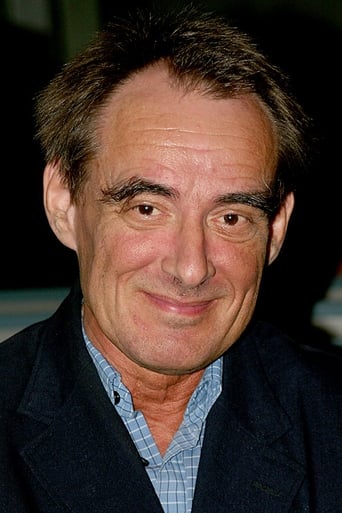Exoticalot
People are voting emotionally.
Pluskylang
Great Film overall
ShangLuda
Admirable film.
Pacionsbo
Absolutely Fantastic
Hannah Lee Olson
You, the Living (Sweden, 2007) captures every day life's sorrows, joys, and regrets through the world's best medicine, humor. Roy Anderrsson, the director and writer of You, the Living, uses off beat sarcasm similar to that of Monty Python to portray short clips of unglamorous people from all different walks of life. Although many of the characters appear to be in the dumps, the whimsical comments and random actions in the background make for a somewhat lighthearted film.Within You, the Living there is no clear plot line nor do all of the characters have an actual name but they all a story to tell. The film opens with a frumpy middle-aged man snoring and fast asleep on a sofa. In the background you can see that there is a fake skyline out the window, which added a humorous touch on the set. The man suddenly awakes and states: "I just had a nightmare". This first scene set the anticipation for odd and out of place interactions.In addition to the snoring man on the sofa there are several other absurd and rather interesting characters. For example, there's the tuba player that announces he lost his retirement money while having unexciting sex with his wife, the teacher that cries in front her class because her husband called her a hag, the man that gets invited to a dinner party and sent to an electric chair shortly after etc. Collected together these characters create a theme of the common man's life and how dismal yet silly it can be.A way that these strange characters escape their dismal lives and find deeper meaning is through music. Some of the characters are members of a Louisiana music band that plays at rather strange venues. Each individual member of the band is given their own independent life snapshot; showing them practicing their music while having rather boring lives. Though their lives are unexciting they're band is a offbeat and quirky. For example, the band plays upbeat New Orleans music at a funeral, which at first appears inappropriate. That is until a woman accompanying the band sings a song about living in a land without tears or sorrow. The song combined with the place and circumstance added to the nature of the film as I found it comedic, touching and somber.Intertwined with music there is a theme of desiring to be loved and feeling unloved. Anna, a hopeless purple boot-wearing romantic, desires to be with, Micke Larsson, the lead singer and guitarist of a punk rock band. Anxious to see him, she practices telling him that she thinks, "he sounded great" at the show, she wishes he called her, and ultimately that she loves him. None of these words are actually spoken to him, which reveals her desperate nature and desire to be loved by him. Towards the end of the film, Anna describes a dream in which she marries Micke. The dream has Micke and Anna post wedding relaxing in a moving house. The house comes to a standstill in front of a crowd of random people that congratulate them on their marriage. The scene was rather bittersweet because the dream was whimsical and charming but the reality is that Anna will always long for his love.Though all the characters faced quite different hardships one consistency was having random people with blank stares scattered throughout the majority of scenes. Literally almost every scene had a random nurse or bystander in the background that would stare directly at the camera as someone talked. At first I thought the stares were just to add comedic effect but it also brought attention to those in the background. This effect made me wonder who the main subject was of each scene. Additionally, it showed that extras could have an impact on the scene greatly when in a position to stick out.The director, Roy Andersson, used many camera techniques to make the scene comical yet bleak. For example, he used dark colored lens to show the baseness of the plain character's lives. In contrast with these colors he had fake painted skylines that made it hard to take the scene seriously. The majority of Andersson's scenes were used with a tripod and showed the entirety of the scene. This made me feel as though I was an additional bystander observing these people's lives whether it was from across a street, through a door, or against a wall.Overall the film was quite absurd and mildly entertaining in some scenes. I would recommend this film to anyone that like's Monty Python's humor and doesn't need an in depth story line to be entertained.
Artimidor Federkiel
Ah yes, Roy Andersson. That humble, down-to-earth guy, famous creator of oodles of award winning commercials with a Scandinavian sense of super dry dead-pan humor peppered with a touch of surrealism and the absurd. He's also undisputed champ of static shots and builder of pitch-perfect studio sets, a director who prefers vignettes over a consistent story to make a picture, and quite an essential (post-)modern film-maker. Located somewhere between Bergman, Fellini, Buñuel, some say even Monty Python, he draws from all of them in a way, and yet is entirely unique by doing his own thing - filming losers, life, people caught in the clutches of capitalism, haunted by guilt, with death, destruction and the dark cloud of the apocalypse always hanging over life, the universe and everything. "Songs from the Second Floor" (2000) marks part one of his still unfinished trilogy. "Songs" is bleak, depressing, revealing, thought-provoking with dark comedy mixed in it, and, naturally, a must-see."You, the Living" (2007) returns to the same world in a comedic way, sort of. "Sort of" because among other things there's of course that streetcar named "Lethe", the name of one of the rivers of death in ancient Greek myth, and people stream out into their lives from it, zombie-like blocking its path... Fitting to the river of forgetfulness a bartender regularly reminds us again and again: "Last drink!" Other people have little to remember, but dream their lives away, in romantic fashion far removed from reality, feel nightmarish bombers looming or embarrass themselves by trying to impress others, and get the death penalty before they wake up. At least they finally provided entertainment that way, as popcorn is handed out at the electric chair. Between dreams, hopes and impending doom life has to be lived, and it's full with its little quirks, pumped up by Andersson to the point of hilarious grotesqueness however presented realistically. Or the other way round. By marrying these apparent extremes without focusing on a central story in a painterly style we enter a state of mind that helps us to evaluate, appreciate and apprehend the fun way: you know, learn more about those guys addressed by the movie that are just mirrored on screen, supposedly known as "the living". Because we shouldn't be surprised that while we hold our heads high towards heaven our life as we know it will be extinguished at the end. That bombshell of a bummer would be the point when we - as the living - should have figured it all out, or at least have an inkling what all that Dixieland jazz is actually about...
Harry Rogers
This film restores your faith in film making.The director takes what appears to be simple moments in life and displays them as cinematic voyeurism , principally of ourselves.They say to express something simply in art is one of the hardest things to do however the director gives us a lesson in austerity. The end result is a mirror of our day to day existence and perhaps the banality of it or for the optimists.. the beauty.Some scenes capture moments in life that would pass the observer by without a second thought however when seen on the screen it gives a whole new meaning to existence and the futility of the day day to progress of ordinary lives.
kayangel1431-1
"I had a dream last night..." This repeated line sets the tone and much of the plot for Roy Andersson's film You, the Living. You, the Living is a film that gives the viewer a few scenes of a number of people's lives and gives them the opportunity to see what the characters had dreamed the night before. These characters live very mundane and repetitive lives and the movie goer is given an opportunity to see into their more fantastical imaginings about what their life could be like. This non-linear story progresses through a series of glimpses into the everyday lives of a number of characters – some who turn out to be connected to each other and others who do not. The repetition of the music of the 'New Orleans' jazz band and the phrase "I had a dream last night" are the strongest connections that the viewer can make to understand the story. Roy Andersson seems to be taking a study of the everyday realities of human life and the mundane repetition that compromises so much of it. Andersson is able to manipulate these realities by looking into the dreaming minds of his characters, and showing what their dreams from the previous night actually looked like – playing them out as if they were a part of reality. The audience gets to see everything from a man put to death for breaking antique china – to a young woman marrying a rock star and the awesome times they have together. These dreams are completely absurd but played out as if they were completely realistic. Overall it is an interesting story that attempts to look at reality and absurdity together.I think that the different dreams that Andersson (and the writers) have chosen for their characters to have and for the audience to see are very interesting and completely opposite of each other in every way. On the one hand we have the dream of broken china and the death penalty. If I were a psychologist I'm sure that I could have a field day with all the dreams in this movie, but the first one seems to have the most blatant symbolism of fear about public performance and a fear of death. I adore how this man is overwhelmed by this feeling that he must be the entertainment at a sad dinner wake and the way that his dream plays out. Andersson is brilliant in the extremely careful setup as he exams the different pieces of china and the different sides of the table cloth – only to have all his worst fears come true when the china comes flying off with the table cloth. We then move on to the masterfully absurd court scene in which this poor, scared out of his wits gentleman is sentenced to death for his awful crime of destroying antique china.Andersson uses absurdism to point out a lot of the more quirky aspects of our everyday lives that we may just not be paying attention to. He contrasts the daily call for last drinks at the local bar with a young woman's dream of her life as it would be married to a rock star. By using so many extremes in the film Andersson is able to get at the quintessential idea that life can be mundane and repetitious if we allow it to be, but if we dream big dreams and try to pursue bigger things, our lives can be more than just the daily grind we live through every day.While I found this film difficult to follow at times, and slightly confusing in the formatting – with periods of very little dialogue and seemingly unconnected actions, in a close viewing I really enjoyed the overall message of the film. I found the filming style of Andersson to be very interesting and it is clear that he is a real masterful filmmaker. He was able to connect a group of seemingly unconnected scenes in an interesting and entertaining way. I think that this is the type of film that only gets more compelling and interesting as you view it multiple times. As you continue to understand the connections of the characters and how their dreams fit into the realities that they live you are able to see how compelling the story of everyday life can be especially when you look at the dreams that go with it. Overall I recommend this film if you are willing to dedicate yourself to the multiple viewings it takes to truly appreciate it.



